Physics 1
A small sphere is moving at a constant speed in a vertical circle. Which of the following quantities is changing?
i. kinetic energy ii. potential energy iii. momentum
i and ii only
i and iii only
i and ii only
ii only
iii only
ii and iii only
In the system of two blocks and a spring shown below, blocks 1 and 2 are connected by a string that passes over a pulley. The initially unstretched spring connects block 1 to a ridged wall. Block 1 is released from rest, initially slides to the right, and is eventually brought to rest by the spring and the friction on the horizontal surface. Which of the following is true of the energy of the system during the process?
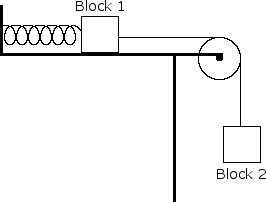
E. The potential energy lost by block 2 is greater in magnitude than the potential energy gained by the spring
In the situation above, after block 1 comes to rest, the force exerted on the rope must be equal in magnitude to
A. Zero
B. the frictional force on block 1
C. the vector sum of the force on block 1 due to the friction and tension in the spring
D. the sum of the weights of the two blocks
E. Shiang doesn't care, he just wants to sleep
F. the difference in the weights of the two blocks
A rope of length is attached to a support at point C. A person of mass sits on a ledge at position A holding the other end of the rope so that it is horizontal and taut, as shown below. The person then drops off the ledge and swings down on the rope toward position B on a lower ledge where an object of mass is at rest. At position B the person grabs hold of the object and simultaneously lets go of the rope. The person and object then land together in the lake at point D, which is a vertical distance below position B. Air resistance and the mass of the rope are negligible. Derive expression for each of the following in terms of , , , and .
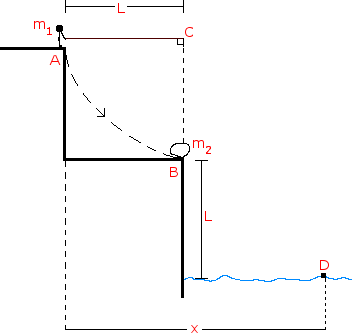
E. The total horizontal displacement x of the person from position A until the person and object land in the water at point D.
A spherical non rotating planet has a radius R and a uniform density throughout its volume. Suppose a narrow tunnel were drilled through the planet along one of its diameters as shown in the figure below, in which a small ball of mass m could move freely under the influence of gravity. Let r be the distance of the ball from the center of the planet. Suppose the ball is dropped into the tunnel from rest at the planet's surface.
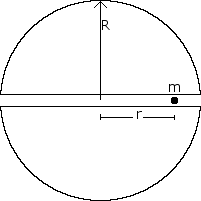
F. Write an equation that could be used to calculate the time it takes the ball to move from point P to the center of the planet.
A solid brass block of mass m slides along a frictionless track when released from rest along the straight section. The circular loop has a radius R.
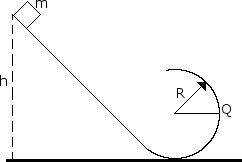
B. Assume the block is released at height h = 6.0 R, what are the magnitude and direction of the horizontal force competent acting on the block at point Q?
A 50 kg object is to be launched 7 x 10 m out into space (not into orbit, it will fall back to earth). Given that the radius of the earth is 6.4 x 10 m and the mass of the earth is 6.0 x 10 kg, find:
A. The work done to put the object that far into space.
B. The total kinetic energy of the object required to put the object that far into space.
C. The binding energy.
D. The escape velocity.
A 60 kg object is to be launched into orbit, 7 x 10 m above the Earth's surface. Given that the radius of the earth is 6.4 x 10 m and the mass of the earth is 6.0 x 10 kg, find:
A. The work done to put the object into orbit.
B. The velocity required to put the object into orbit.
C. The velocity of the object once it is in orbit.
A 2kg car is traveling east at 3 m/s and a 4kg car is traveling west at 6 m/s. Assume the cars collide and stick together. Find the direction and velocity of the cars after they collide.
A 2kg car is traveling east at 3 m/s and a 4kg car is traveling west at 6 m/s. Now assume the cars bounce off each other in a perfectly elastic collision. The final velocity of the 2kg car is -4 m/s. Find the direction and velocity of the other car after the collision.
A champagne bottle of mass 90 g has a 2 g cork in it. The pressure built up in the bottle causes the cork to shoot out, as shown below. If after the explosion, the bottle is moving directly to the left at 4 m/s, what is the velocity of the cork?

The red ball (4 kg) hits the blue ball (5 kg) moving at 2 m/s, and the balls move as shown in the figure below. = 30 degrees. After the impact, the red ball is measured moving at 1.8 m/s. What is the velocity of the blue ball, and at what angle relative to the horizontal is the ball moving after the impact?

The mass shown below is blown apart into three pieces. Find the direction and velocity of the pink piece.
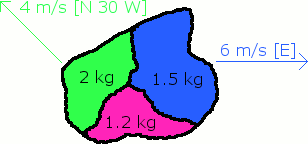
A crash test car of mass 1,000 kg moving at a constant speed of 12 m/s collides completely inelastically with an object of mass M at time t = 0. The ojbect was initally at rest. The speed v in m/s of the car object system after the collision is given as a function of time t in seconds by the expression
A. Calculate the mass M of the object
B. Assuming an initial position of x = 0, determine an expression for the position of the car object system after the collision as a function of time t.
C. Determine an expression for the resisting force on the car object system after the collision as a function of time t.
D. Determine the impulse delivered to the car object system from t = 0 to t = 2.0 s.
In a laboratory experiment, you wish to determine the initial speed of a dart just after it leaves a dart gun. The dart of mass is fired with the gun very close to a wooden block of mass which hangs from a cord of length and negligible mass as shown below. Assume the size of the block is negligible compared to and the dart is moving horizontally when it hits the left side of the block at its center and becomes embedded in it. The block swings up to a maximum angle from the vertical. Express your answer to the following in terms of , , , , and .
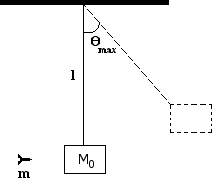
C. The dart is now shot into a block of wood that is fixed in place. The block exerts a force F on the dart that is proportional to the dart's velocity v and in the opposite direction, that is F = -bv, where b is a constant. Derive an expression for the distance L that the dart penetrates into the block in terms of m, , and b.
The wheel shown below has eight equally spaced spokes and a radius of 30 cm. It is mounted on a fixed axle and is spinning at 2.5 rev/sec. You want to shoot a 20 cm long arrow without hitting any of the spokes. Assume the arrow and the spokes are very thin.
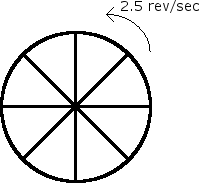
B. Does it matter where between the axle and the rim of the wheel you aim? If so what is the best location?
A flywheel turns through 40 rev as it slows from an angular speed of 1.5 rad/s to stop.
A. Assuming constant angular acceleration find the time for it to come to rest.
B. What is its angular acceleration?
C. How much time is required for it to complete its first 20 of the 40 revolutions?
A massless string is wrapped around a disk of rotational inertia I = . The disk falls and spins as it falls, unraveling the rope. Determine the tension in the string and the acceleration of the disk.

A solid brass sphere of mass m and radius r << R rolls along a track when released from rest along the straight section. The circular loop has a radius R.
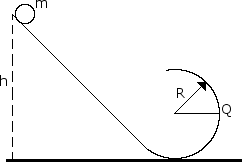
B. Assume the sphere is released at height h = 6.0 R, what are the magnitude and direction of the horizontal force competent acting on the sphere at point Q?
A pulley of radius R1and rotational inertia I1is mounted on an axle with negligible friction. A light cord passing over the pulley has two blocks of mass mattached to either end, as shown below. Assume that the cord does not slip on the pulley. Determine the answers to parts (A) and (B) in terms of m, R1, I1, and fundamental constants.
